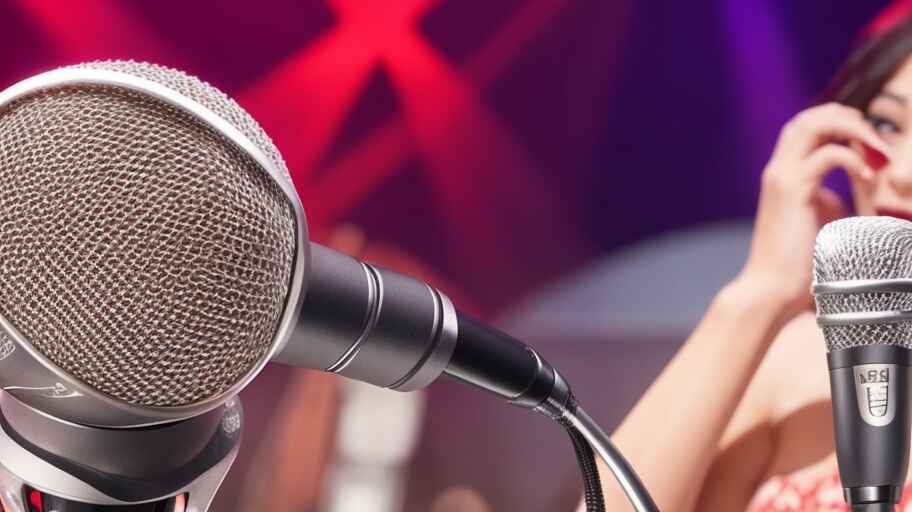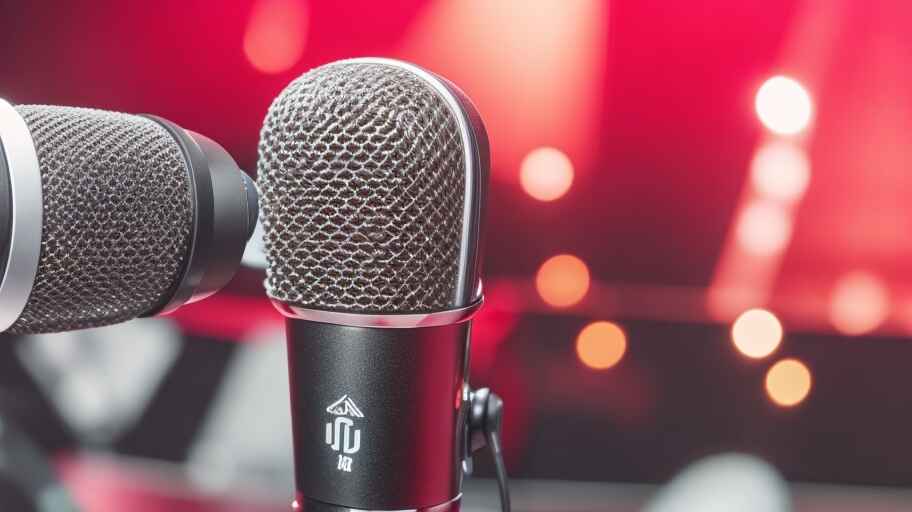What Microphones do Singers Use on Stage? Well, it’s not just about belting out the high notes; it’s about picking the perfect vocal sidekick.
Imagine singing your heart out only to have your microphone throw a tantrum!
Curious about the magic behind those mics? Keep reading to discover the secrets that make your favorite singers sound oh-so-sweet on stage!
Why is Microphone Selection Crucial for Singers Performing Live?

Before we delve into the specific types of microphones singers use on stage, let’s understand why microphone selection is of paramount importance in a live performance setting.
When you step onto the stage, you’re not just singing; you’re telling a story, conveying emotions, and connecting with your audience.
Your microphone is the bridge that carries your voice to your listeners, and it must faithfully reproduce the nuances of your performance.
A microphone that doesn’t suit your voice or style can result in poor sound quality, making it difficult for the audience to connect with your music.
It can also lead to issues like feedback or distortion, which can be distracting and disheartening.
What Microphones do Singers Use on Stage: Dynamic vs. Condenser
Now, let’s explore the two main types of microphones singers commonly use on stage: dynamic and condenser microphones.
Dynamic Microphones
Dynamic microphones are the workhorses of the live music world.
They are durable, reliable, and well-suited for handling high sound pressure levels, making them a popular choice for rock, pop, and metal vocalists.
Pros of Dynamic Microphones:
- Excellent at handling loud volumes without distortion.
- Durable and robust, suitable for touring.
- Effective at isolating background noise.
Cons of Dynamic Microphones:
- May lack the sensitivity to capture subtle nuances in a vocalist’s performance.
- Limited frequency response compared to condenser microphones.
Condenser Microphones
Condenser microphones are prized for their sensitivity and accuracy in capturing vocals.
They excel at reproducing the subtleties of a singer’s voice, making them a favorite among acoustic and classical performers.
Pros of Condenser Microphones:
- Exceptional sensitivity and frequency response.
- Ideal for capturing intricate vocal details.
- Suited for genres requiring a nuanced and transparent sound.
Cons of Condenser Microphones:
- More fragile and less rugged than dynamic microphones.
- Prone to distortion at high sound pressure levels.
Pros and Cons of Wireless Microphones for Singers in Live Shows

In the modern era of live performances, freedom of movement is highly valued by singers.
Wireless microphones provide this freedom, allowing vocalists to move around the stage without being tethered to a cable.
However, they come with their own set of advantages and disadvantages.
Pros of Wireless Microphones:
- Mobility: Singers can move freely on stage, engaging with the audience and creating a dynamic performance.
- Aesthetics: No visible cables create a cleaner and more professional stage appearance.
- Less Risk of Tripping: Eliminating cables reduces the risk of accidents during the performance.
Cons of Wireless Microphones:
- Cost: Wireless microphone systems are generally more expensive than their wired counterparts.
- Interference: Signal interference can disrupt the performance if not properly managed.
- Battery Life: Singers need to ensure their wireless microphones are adequately powered to avoid sudden cut-offs.
In-Ear Monitors and Microphones: The Ultimate On-Stage Combo?
In-ear monitors (IEMs) have revolutionized live performances for singers.
These earpieces not only provide clear audio monitoring but also serve as a means of communication with the band and sound engineers.
When combined with the right microphone, IEMs can create an immersive and controlled on-stage experience.
Popular Microphone Models Loved by Famous Singers on Tour
Famous singers often have their preferences when it comes to microphones on stage.
Let’s take a look at some of the beloved microphone models that have graced the hands of music legends during their tours.
- Shure SM58: This iconic dynamic microphone is known for its durability and reliability. It has been a staple for numerous rock and pop performers.
- Neumann U87: A favorite among studio vocalists, the Neumann U87’s transparent and detailed sound has also found its way onto many stages.
- Sennheiser e945: This dynamic microphone is highly regarded for its ability to cut through loud stage mixes, making it a top choice for vocalists in high-energy bands.
Tips for Proper Microphone Technique for Singers on Stage

Selecting the right microphone is just one part of the equation.
Proper microphone technique is equally crucial for delivering a captivating performance.
Here are some tips to ensure you get the most out of your microphone on stage:
- Maintain the Correct Distance: Find the sweet spot where your voice sounds best on the microphone, usually a few inches away.
- Avoid Plosives: Use a pop filter or angle the microphone slightly to prevent explosive sounds from ‘p’ and ‘b’ sounds.
- Control Your Breath: Breathe deeply and control your exhalation to maintain consistent volume and avoid breath noises.
- Move with Purpose: If using a handheld microphone, use deliberate movements to enhance your performance, but be mindful not to create feedback.
To gain more insight into Singers Put their Mouth on the Microphone, SM57 good for Recording Acoustic Guitar you may find my article:
Why do Singers Put their Mouth on the Microphone?
Is an SM57 good for Recording Acoustic Guitar? Expert Tips
How to Prevent Feedback Issues with Stage Microphones
Feedback can turn a beautiful performance into a sonic nightmare.
It occurs when sound from the loudspeakers re-enters the microphone and creates a loop of amplified noise.
To prevent feedback, consider these strategies:
- Monitor Placement: Position stage monitors away from microphones and use in-ear monitors when possible.
- Microphone Placement: Point microphones away from monitors and speakers to minimize sound bleed.
- EQ Adjustment: Use equalization (EQ) to reduce the frequency bands that are most prone to feedback.
- Soundcheck: Conduct a thorough soundcheck before your performance to identify and address potential feedback issues.
Must-Have Microphone Accessories for a Flawless On-Stage Performance
In the world of live performances, a great microphone is just the beginning.
To achieve a flawless on-stage performance, singers need a selection of key accessories that enhance sound quality, minimize technical issues, and provide overall comfort and confidence.
Let’s explore the must-have microphone accessories every performer should consider:
1. Microphone Stand
A reliable microphone stand is the unsung hero of any live performance.
It allows singers to maintain a consistent and comfortable microphone position, freeing up their hands for gestures and expressive movements.
Look for adjustable stands that can accommodate different heights and performance styles.
2. Microphone Windscreen/Pop Filter
To prevent unwanted pops and breath noises from reaching the microphone, invest in a quality windscreen or pop filter.
These accessories are especially valuable for vocalists who sing close to the microphone, helping to maintain sound clarity and prevent distortion.
3. Microphone Clip or Holder
Microphone clips or holders are essential for securing your microphone to the stand.
They provide stability and prevent accidental drops or movements during your performance. Ensure the clip is compatible with your microphone model for a snug fit.
4. XLR Cables
High-quality XLR cables are the lifeline between your microphone and the sound system.
Invest in durable, well-shielded cables to minimize interference and ensure a clean audio signal. It’s a good practice to carry backup cables in case of unexpected failures.
5. Wireless Microphone System (if using a wired microphone)
If you prefer the freedom to move around the stage without the constraints of a cable, consider a wireless microphone system.
These systems come with a transmitter and receiver, allowing you to maintain audio quality and reliability while going wireless.
6. In-Ear Monitors (IEMs)
As mentioned earlier, in-ear monitors are invaluable for on-stage performers.
They provide a personalized audio mix directly to your ears, ensuring that you hear yourself and your band clearly without relying solely on stage monitors.
IEMs contribute to pitch accuracy and reduce the risk of feedback.
7. Microphone Cleaning Kit
Proper microphone maintenance is essential for sound quality and longevity.
A microphone cleaning kit typically includes brushes, swabs, and cleaning solutions to keep your microphone free from dust, dirt, and moisture.
Regular cleaning ensures optimal performance.
8. Microphone Pouch or Case
Protecting your microphone during transport is crucial.
A padded microphone pouch or case safeguards your microphone from physical damage and environmental factors.
It also keeps accessories like cables and windshields organized and readily accessible.
9. Mic Stand Light
In dimly lit venues, a mic stand light can be a game-changer.
It illuminates your microphone and lyric sheets, making it easier to read lyrics and interact with your equipment.
Look for adjustable lights with brightness control for versatility.
10. Feedback Suppressor/Equalizer
For singers plagued by feedback issues, a feedback suppressor or equalizer can be a lifesaver.
These devices help identify and eliminate feedback frequencies, ensuring a clean and interference-free sound during your performance.
11. Microphone Isolation Shield
If you’re recording your performance or singing in a noisy environment, a microphone isolation shield can reduce unwanted background noise.
It creates a controlled acoustic environment around the microphone, improving sound isolation and clarity.
12. Wireless Microphone Accessories
If you opt for a wireless microphone system, consider additional accessories such as spare batteries for transmitters, antenna boosters for extended range, and carrying cases for secure storage and transport.
13. Personal Mixer (for complex stage setups)
In larger productions with multiple performers and instruments, a personal mixer allows you to control your individual audio mix.
It’s particularly useful if you have specific preferences for the balance of vocals and instruments in your in-ear monitors.
FAQs About What Microphones do Singers Use on Stage
What mic does Adele use on stage?
Adele is known to use the Sennheiser 6000 series wireless microphone system on stage. She prefers its reliability and sound quality.
What microphone does Ariana Grande use on stage?
Ariana Grande often uses the Shure KSM8 Dualdyne microphone during her live performances. It provides clear vocals and minimizes background noise.
What mic did Elvis use on stage?
Elvis Presley famously used the Shure 55S microphone, also known as the “Elvis microphone.” Its iconic design is still associated with him.
What microphone does Billie Eilish use on stage?
Billie Eilish uses the Audio-Technica AT2020 microphone for her live shows. It captures her distinctive vocal style effectively.
What microphone does Beyonce use on stage?
Beyoncé is known for using the Telefunken ELA M 251 microphone on stage. It complements her powerful voice and provides rich sound.
What microphone does Taylor Swift use on stage?
Taylor Swift has been seen using the Sennheiser SKM 2000 series wireless microphone during her live performances. It offers clear audio and durability.
What microphone does Katy Perry use?
Katy Perry often uses the Sennheiser EW 500-935 G3 wireless microphone system. It ensures consistent audio quality during her concerts.
What microphone does Kelly Clarkson use?
Kelly Clarkson frequently uses the Shure Beta 58A microphone on stage. Its dynamic design captures her vocals with precision.
What microphone did Whitney Houston use?
Whitney Houston was known for using the Neumann U87 microphone during her live performances. It contributed to her legendary voice’s warmth and clarity.
Conclusion
In the world of live performances, microphone choice is a critical decision that can significantly impact a singer’s connection with their audience.
Whether opting for dynamic or condenser microphones, wired or wireless setups, the key is to align the microphone with the singer’s unique style and stage requirements.
Proper microphone technique and essential accessories, such as stands, windshields, and in-ear monitors, complete the equation for a flawless on-stage experience.
By understanding the nuances of microphone selection and mastering the art of stage performance, singers can ensure that their voice resonates with clarity, power, and emotion, leaving their audience captivated and enthralled.
